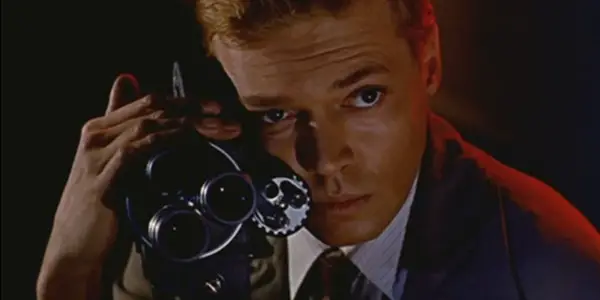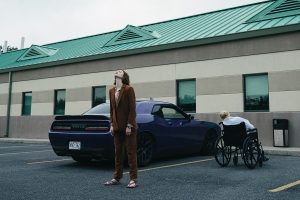
A filmmaker deeply beloved by other filmmakers in addition to generations of fans, Michael Powell is best known for the unparalleled run of masterpieces he made with his collaborator Emeric Pressburger in the 1940s and 1950s: the charming romance I Know Where I’m Going!, the dance-fueled fantasia The Red Shoes, and the heated psychological drama Black Narcissus, just to name a few. Yet in a cinematic oeuvre full of films that are visually stunning and narratively rich, Powell never made another movie quite as visceral—quite as vicious—as his 1960 solo effort Peeping Tom. Now screening in a brand-new 4K restoration from The Film Foundation and BFI National Archive in association with STUDIOCANAL—with Powell apostle Martin Scorsese and Powell widow Thelma Schoonmaker serving as consultants—Peeping Tom is a thrilling examination of the dangers inherent in making and watching moving pictures. Initially dismissed by critics and audiences alike, it is now known as a cult classic that paved the way for so many films to follow.
Who Saw Her Die?
The bravura opening sequence of Peeping Tom is one that, like other sequences later on in the film, takes us behind the camera, allowing us to view the scene through its viewfinder—and by extension, the killer’s point of view. In immediately making the audience a participant in the killing, even if merely by observing it, Powell emphasizes the voyeuristic quality of watching movies, something that Roger Ebert said in a 1999 review of the film “is the bargain the cinema strikes with us, although most films are too well-behaved to mention it.” But Peeping Tom is a film that behaves badly from the very first shot, as our protagonist’s roving camera, hidden from his prey underneath his coat, follows a sex worker up the stairs into her seedy flat and records her screams of terror at the moment she is murdered.
source: STUDIOCANAL
Later, we find ourselves watching the killer as he watches the footage back in his home darkroom. He is Mark Lewis (German actor Karlheinz Böhm, credited here as the more Anglicized Carl), a studio focus-puller who aspires to be a filmmaker himself; as a side job, he takes photos of scantily clad women that are sold under the counter at a local newsstand. Growing up, his father, a psychologist who specialized in cataloging and analyzing reactions to fear, compulsively recorded Mark’s every move, even going so far as to film his reactions to watching a young couple in a clinch, finding a lizard tossed into his bed (by his father, naturally), and bidding farewell to his mother on her deathbed. Now, Mark carries on his work by murdering women with a knife hidden in one of the legs of his tripod and attempting to capture their final moments—the ones where their fear reaches a fever pitch—on film for posterity.
Later, Mark even goes so far as to commit murder on the studio backlot, filming the final moments of a studio bit player (the divine Moira Shearer, showing she could still spin around set like a redheaded whirling dervish twelve years after The Red Shoes) and then attempting to also document the resulting investigation, claiming it’s for a documentary—which, strictly speaking, isn’t really a lie. But his compulsion to create and document these savage scenes is hindered by his burgeoning relationship with Helen Stephens (Anna Massey), a kindhearted young woman who lives with her blind mother as tenants in Mark’s large house. Helen is writing a children’s book about a magical camera and wants Mark to provide the illustrations. One could almost be tricked into thinking Helen’s affection could save Mark from his inevitable fate; indeed, as the film progresses, one cannot help but hope for it. But alas, Mark has already scripted a tragic ending for his twisted tale, one that grows increasingly impossible for him to deviate from.
All the Colors of the Dark
In its focus on voyeurism and the compulsive desire to watch—a desire that itself often contains an undercurrent of violence—Peeping Tom references the classic Hitchcock thrillers Vertigo and Rear Window. But the film doesn’t just look back; it also looks forward, foreshadowing the rise in popularity of the slasher film that was to occur in the coming decades. Indeed, Peeping Tom feels like a British precursor to Italian giallo, the stylish and sadistic horror subgenre that began to boom in the early 1960s with films like Mario Bava’s The Girl Who Knew Too Much (its title also showing Hitchcock’s ever-prominent influence) and Dario Argento’s The Bird with the Crystal Plumage. From the family-induced trauma that inspires Mark’s murderous madness to the focus on sadomasochism and sexual deviance to the bevy of beautiful redheads that fill the film’s cast, one cannot help but catch glimpses of what would later become well-known giallo tropes everywhere you turn in Peeping Tom.
source: STUDIOCANAL
As Mark, Böhm’s baby-faced blonde beauty makes him not only an unlikely killer but one that it is all too easy to become ensnared by—a danger faced by the film’s characters as well as its audience. Soft-spoken and shy, his closest companion is his camera, which is never far from his grasp. When Helen convinces him to leave it behind when they go out for a bite to eat, even going so far as to lock it in her room, one can see on Mark’s face how monumental a difficulty this is for him to overcome. Yet overcome it he does, going out with Helen and seemingly having a lovely time. It’s moments like these that draw the audience into a tangled web of wishful thinking; yes, Mark has already committed murders, but maybe Helen’s love can help him redeem himself and become a new man, one who doesn’t hide a blade in his tripod!
It’s a credit to Leo Marks’ many-layered script and Böhm’s brilliant performance that one is able to hover on the verge of having sympathy for this character—and really, when he details to Helen the psychological torture he faced at the hands of his father, even going so far as to show her the films his father made of these traumatic moments, how can you not? Meanwhile, Massey brings a wholesome sensitivity to Helen that makes you desperately root for her survival; she embodies the girl next door—both figuratively and literally—as well as the final girls that would go on to populate the horror genre.
source: STUDIOCANAL
Shot on Eastmancolor 35mm stock, Peeping Tom is rich with the lush, saturated colors that one expects from a Michael Powell film; yet while such vivid visuals added to the mystical quality of films like The Red Shoes and A Matter of Life and Death, here they look lurid and even gruesome, with liberal use of red lighting and dark shadows adding to the seediness of the atmosphere and rendering the whole world Mark’s darkroom. The jangling piano score written by Brian Easdale and performed by Gordon Watson further emphasizes the anxiety-inducing nature of the film’s plot. It’s impossible not to be on the edge of your seat watching Peeping Tom; you want to take in every glorious shot, courtesy of cinematographer Otto Heller, even as your heart starts to race faster and faster and you too nearly succumb to the fear that plagues Mark’s victims in their final moments. You should look away, but you can’t, and you won’t—and that’s how your morbid fascination makes you complicit in Mark’s actions, even if you yourself have never harmed a fly.
Conclusion
That Peeping Tom was reviled by contemporary critics to the point of doing permanent damage to Powell’s directorial career feels almost unconscionable. It’s a horror classic of the highest order, a piece of master filmmaking by an iconic artist at the top of his game.
The new 4K restoration of Peeping Tom begins screening at Film Forum in New York on November 24, 2023.
Does content like this matter to you?
Become a Member and support film journalism. Unlock access to all of Film Inquiry`s great articles. Join a community of like-minded readers who are passionate about cinema – get access to our private members Network, give back to independent filmmakers, and more.




